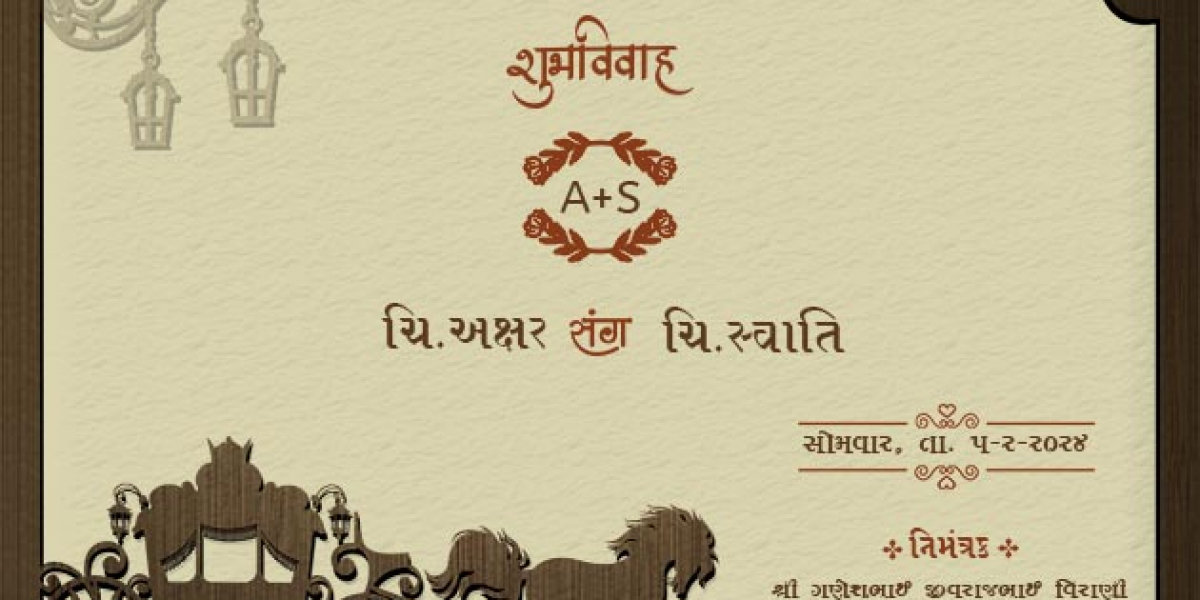In the vibrant tapestry of Indian traditions, Kankotri Lakhan in Gujarati holds a special place. The art of creating and sending Kankotri, or wedding invitation cards, is steeped in cultural significance and is a deeply rooted practice in Gujarati customs. These invitations are not just mere formalities; they are a reflection of the family’s heritage, values, and the joyous occasion they represent. In this article, we delve into the rich tradition of Kankotri Lakhan, exploring its history, cultural importance, and the intricate details that make it an essential part of Gujarati weddings.
The Historical Significance of Kankotri Lakhan
Kankotri Lakhan, the practice of crafting wedding invitations, has a long and storied history in Gujarati culture. Traditionally, Kankotris were handwritten on ornate paper, often embellished with gold or silver ink, and decorated with intricate designs that reflected the family's social status and aesthetic preferences. These invitations were considered sacred and were often accompanied by religious symbols, such as images of Lord Ganesha, who is revered as the remover of obstacles and the god of new beginnings.
The term "Kankotri" itself is derived from the Sanskrit word "Kankotram," which means "invitation." Over centuries, the practice of Kankotri Lakhan evolved, but it has always maintained its cultural and religious significance. The process of sending out Kankotris is seen as an auspicious start to the wedding festivities, and great care is taken in their preparation and distribution.
Cultural Importance of Kankotri Lakhan in Gujarati Weddings
In Gujarati weddings, the Kankotri is more than just an invitation; it is a symbol of respect and an expression of goodwill towards the guests. The invitation serves as the first glimpse of the wedding, setting the tone for the upcoming celebrations. The design, language, and presentation of the Kankotri are carefully chosen to reflect the family's traditions and the significance of the event.
The language used in Kankotri Lakhan is often a blend of Gujarati and Sanskrit, with verses and phrases that convey blessings and good wishes. The content of the invitation is also imbued with cultural references, including quotes from ancient scriptures, prayers, and the mention of the family’s lineage. The traditional Kankotri not only invites the guests to the wedding but also includes a formal request for their blessings, making it a heartfelt and personal gesture.

Design and Aesthetics of Traditional Kankotris
The design of a traditional Kankotri is a reflection of the family's cultural heritage and artistic preferences. Traditionally, Kankotris were handwritten on handmade paper or vellum and were decorated with intricate designs that included floral patterns, paisleys, and religious symbols. The use of gold or silver ink was common, and the borders of the Kankotri were often embellished with zari work or embossed patterns.
Modern Kankotris, while still maintaining traditional elements, have evolved to include a wide range of designs and materials. Today, Kankotris are often printed on luxurious paper stock with digital printing techniques that allow for more intricate and vibrant designs. The use of foiling, embossing, and laser-cut detailing has also become popular, adding a contemporary touch to the traditional art form.
The choice of colors in a Kankotri is also significant. Red, gold, and yellow are commonly used colors as they are considered auspicious in Hindu culture. However, modern Kankotris may also feature pastels or metallic hues, depending on the theme of the wedding and the family's preferences. The design of the Kankotri often includes motifs that are significant to the couple or their families, such as peacocks, lotus flowers, or mangalsutras.
The Process of Kankotri Lakhan
The process of Kankotri Lakhan begins with selecting the design and content of the invitation. Traditionally, the family consults with a pandit (Hindu priest) to choose an auspicious date and time for writing the Kankotri. This practice, known as Muhurta, ensures that the invitations are written and sent out at the most favorable time, according to Hindu astrology.
Once the design and content are finalized, the invitations are either handwritten or printed, depending on the family's preference. Handwritten Kankotris are considered more personal and are often preferred for intimate weddings, while printed Kankotris are more practical for larger celebrations. The content of the Kankotri typically includes the names of the bride and groom, their families, the date and venue of the wedding, and a formal request for the guest's presence and blessings.
The distribution of the Kankotris is also a significant ritual. In many Gujarati families, the first invitation is sent to the family deity, a tradition known as Deva Naara. This is followed by sending out invitations to close family members, friends, and other guests. The act of delivering the Kankotris is often accompanied by sweets or small gifts, further emphasizing the importance of the occasion.

Modern Trends in Kankotri Lakhan
While the traditional elements of Kankotri Lakhan remain cherished, modern trends have also influenced the way these invitations are designed and presented. One such trend is the rise of eco-friendly Kankotris, made from recycled paper and printed with vegetable-based inks. These invitations are not only environmentally conscious but also align with the growing awareness of sustainability among younger generations.
Another modern trend is the use of digital Kankotris. With the advent of technology, many families are opting for digital invitations that can be sent via email or social media. These e-Kankotris often feature animated designs, music, and interactive elements, offering a modern twist on the traditional invitation. Digital Kankotris are also convenient for families with guests spread across different parts of the world, as they can be sent instantly and at a lower cost.
Despite these modern innovations, many Gujarati families still prefer the traditional Kankotri, seeing it as an essential part of their cultural heritage. The tactile nature of a physical invitation, the care taken in its design and delivery, and the personal touch it conveys are aspects that cannot be fully replicated by digital means.
Conclusion
The tradition of Kankotri Lakhan in Gujarati culture is a beautiful expression of heritage, respect, and the joy of coming together to celebrate a union. Whether traditional or modern, the Kankotri remains a cherished part of Gujarati weddings, embodying the values and aesthetics that have been passed down through generations. As this tradition continues to evolve, it retains its core significance, connecting families and communities in the celebration of love and unity.









